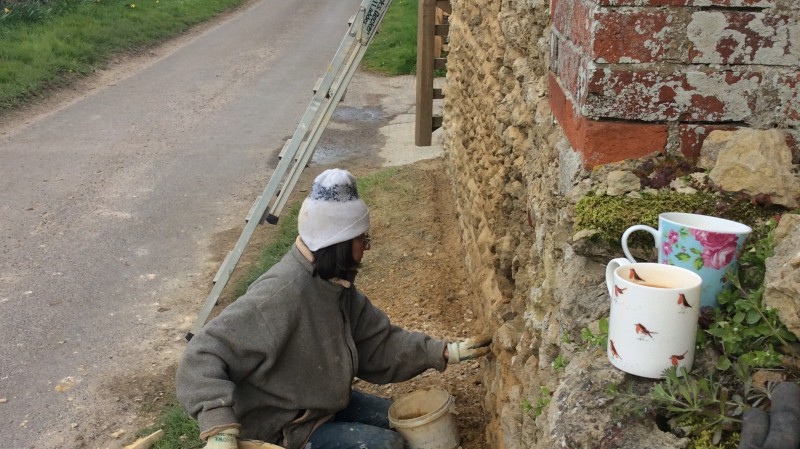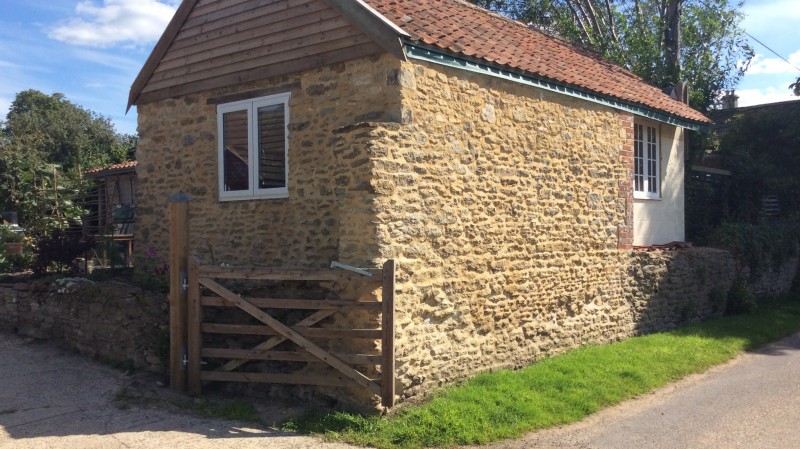You are here: Repointing a stone outbuilding
Background
Renovating the Tack Room was a project planned for many years. The outbuilding had had a few uses including storage and office but after the roof started rotting and then leaking we applied for planning permission to convert to a living area and about 2 years later started the work. The predicted 6 months for completion was a massive under estimation, and now over 2 years later work is not yet complete.
Repointing the outside walls took about a couple of months on and off. Lime mortar cures slowly and must not freeze so when work began in March it was often too cold (less than 5 degrees) and even in May there were some night frosts. As well as this, some high day time temperatures meant the mortar would have dried out too quickly, so again work was delayed.

Preparation
The northwest facing wall was the most weathered and in poorest condition. Removing the old mortar wasn’t too hard as it was very sandy with not too much cement. The other two walls, although less area, had more previous repair work , which had been done with cement, often covering the stone face, which was much more difficult to remove.
The best way to remove the old mortar and cement was to use a single pick hammer, and sometimes a hammer and chisel. A screw driver was also useful to scrape the old mortar out. The stones, both top and bottom, need to be exposed to give the new mortar a surface to stick to. To finish off, the stones were hosed down, to remove excess sand and to clean.
The NW facing face was done in three vertical sections, removing old material, and then mortaring, and then on to the next section. The other 2 smaller walls were completed in one go. It was a time consuming, unpleasant job; a good way to get repetitive arm and hand injury. It was best to wear goggles and cap to prevent being covered with old mortar and sand.
The repointing mix
A very old random stone wall without damp course must be allowed to breathe so any moisture can escape through the mortar. Do not be tempted to use any Portland cement in the mix.
Our mix was: 1 part 3.5 hydraulic lime
1 part grit sand
2 parts builders’ sand
Water to mix to a paste
It was easier to mix in a cement mixer rather than by hand and a mask should be used as the lime powder shouldn’t be inhaled. The mix should be slightly firm and stick to an upturned trowel. If too much water is added the mortar is likely to crack when it dries out.
Unfortunately we didn’t count the amount of mix we used in total.
Repointing
Gloves need to be worn so the lime doesn’t burn the skin, either work gloves or gardening are suitable. Fill a gardening trowel with mortar and rest on the stones below the gap to be filled. Push the mortar into the gap with a spatula, then push it in either with the spatula or with your hand. It is important to fill the gap completely and if necessary small stones can be used where the gaps are large. Once filled, smooth off either with the spatula or side of your hand.
If the mix is more solid the mortar can be placed by the handful straight into the gaps and the spatula is less useful.
When the mortar has firmed up after a few hours (or sooner if the weather is dry and warm), use a nylon hand brush and bash it along the mortar to make sure it’s in place and to remove any excess. At the end of the day, use a fine spray with the garden hose to completely wet the wall and repeat for 3 to 4 days to prevent it from drying out too quickly and cracking.
For these walls it was impossible to achieve a smooth straight wall finish. The stones were far from even and to have a straight finish would have meant covering more stone with even more mortar which would have spoilt the overall effect. This may mean that some moisture may rest on some of the stones rather than run off.
The new mortar has transformed the look of the outside of the building and has also helped preserve the building for many more years.

If you are looking to make some home improvements, you may find some of these services useful
Builders
Find local help with a building project
Building Regulations
Find details of local experts who can help with Building Regulations
Architectural Design Services
Find local Architectural Design experts
Structural Inspections
Find an expert to carry out a structural inspection
Building Surveys
I want a local surveyor to do a Building Survey for me
Choose which Architectural service you require
If you are not sure which service you require, check out the options available...


